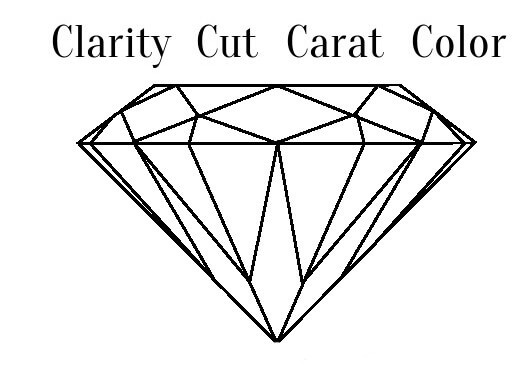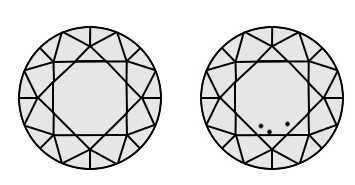If one considers the natural phenomenon behind the creation of a diamond, one becomes aware of how fascinating the small gemstones actually are.
No pressure - no diamonds

Already more than millions of years ago the diamonds known to us today originated in the interior of our planet. But it was only about 100 years ago that the first people in Africa began to actively dig for them. Both the pressure inside and volcanic eruptions throughout history have made it possible for us to admire the gemstones made of crystallized carbon on our jewellery today. The history of the origin of diamonds is also reflected in their names. The term “diamond” known to us today is derived from the Greek word “Adamat”, the meaning of which can be literally translated as “invincible”.
The properties of a real diamond are determined by the four Cs : Clarity, Cut, Carat and Colour. Carat stands for the weight, Colour for the colour, Clarity for the purity and Cut for the cut of a diamond. For us as jewellers, it is particularly important that the diamonds used also have the fifth C: Conflict. It represents the absence of conflict in diamonds and prevents gemstones from being illegally mined. Only when a diamond has all these qualities is it completely pure in our eyes.
Clarity
As described above, diamonds are formed by the immense influence of pressure inside the earth. In addition, there are also the local temperatures, which are ultimately responsible for the formation of the gemstones. The entire process is called the crystallization process. This in turn is responsible for the inclusions, i.e. the purity of a gemstone. In connection with diamonds one speaks of purity if there are no small inclusions, so-called black dots, in the gemstone. The fewer points, the higher the purity of the diamond. This is achieved and checked with the aid of magnifying glasses in multiple magnifications. A total of eleven categories exist in which the purity of a diamond can be divided. Below you can see two examples of purity. The left diamond has the category “Internally Flawless (IF)”, in which one speaks also of magnifying glass purity and the right “Small Inclusions (SI)”, since small inclusions are to be recognized here. But don’t be deceived by the graphics, because these impurities cannot be seen with the naked eye.

Cut

As the name suggests, the cut of a diamond is behind this term. It is synonymous with the shine and radiance of a cut gemstone. The cut is especially valuable because it is the only step in the process of a diamond that is directly and solely influenced by man. It is only with the cut that the interplay between nature and human craftsmanship is completed and gives the diamonds their familiar radiance in the light.
Carat
When talking about diamonds, the term “carat” is probably most often used. But what does this term stand for and what properties are behind it? As already mentioned, in German the term stands for the weight of a diamond. For this reason, diamonds with a high carat value are also more valuable because they have a higher weight. A “carat”, in German carat, corresponds to the value of 0.2 grams. In the world of diamonds, the unit of measurement carat therefore stands for the reliable weight of a diamond. However, it must be borne in mind that, in addition to size, the quality of a diamond also plays an important role in price formation. Accordingly, a small diamond of 0.50 ct, for example, can be more valuable than a diamond of 2.00 ct.

Colour

Diamonds are available in almost all colours. In most cases the colour of the diamond can be traced back to its natural colour. However, the best known and probably most widespread colour of diamonds is white. In the realm of diamonds in such a case one speaks of the fact that the diamond is colourless. As with purity, the colour of a diamond is also categorized. Beginning with “D” for an exceptional white, the internationally established rating leads to “Z” for a tinted colour.
Helpful tips for the care of your precious diamonds can be found here.
We will be happy to advise you on the choice of your personal diamond.
Your team from Juwelier Mayer

Already more than millions of years ago the diamonds known to us today originated in the interior of our planet. But it was only about 100 years ago that the first people in Africa began to actively dig for them. Both the pressure inside and volcanic eruptions throughout history have made it possible for us to admire the gemstones made of crystallized carbon on our jewellery today. The history of the origin of diamonds is also reflected in their names. The term “diamond” known to us today is derived from the Greek word “Adamat”, the meaning of which can be literally translated as “invincible”.
The properties of a real diamond are determined by the four Cs : Clarity, Cut, Carat and Colour. Carat stands for the weight, Colour for the colour, Clarity for the purity and Cut for the cut of a diamond. For us as jewellers, it is particularly important that the diamonds used also have the fifth C: Conflict. It represents the absence of conflict in diamonds and prevents gemstones from being illegally mined. Only when a diamond has all these qualities is it completely pure in our eyes.
Clarity

As described above, diamonds are formed by the immense influence of pressure inside the earth. In addition, there are also the local temperatures, which are ultimately responsible for the formation of the gemstones. The entire process is called the crystallization process. This in turn is responsible for the inclusions, i.e. the purity of a gemstone. In connection with diamonds one speaks of purity if there are no small inclusions, so-called black dots, in the gemstone. The fewer points, the higher the purity of the diamond. This is achieved and checked with the aid of magnifying glasses in multiple magnifications. A total of eleven categories exist in which the purity of a diamond can be divided. Below you can see two examples of purity. The left diamond has the category “Internally Flawless (IF)”, in which one speaks also of magnifying glass purity and the right “Small Inclusions (SI)”, since small inclusions are to be recognized here. But don’t be deceived by the graphics, because these impurities cannot be seen with the naked eye.
Cut

As the name suggests, the cut of a diamond is behind this term. It is synonymous with the shine and radiance of a cut gemstone. The cut is especially valuable because it is the only step in the process of a diamond that is directly and solely influenced by man. It is only with the cut that the interplay between nature and human craftsmanship is completed and gives the diamonds their familiar radiance in the light.
Carat

When talking about diamonds, the term “carat” is probably most often used. But what does this term stand for and what properties are behind it? As already mentioned, in German the term stands for the weight of a diamond. For this reason, diamonds with a high carat value are also more valuable because they have a higher weight. A “carat”, in German carat, corresponds to the value of 0.2 grams. In the world of diamonds, the unit of measurement carat therefore stands for the reliable weight of a diamond. However, it must be borne in mind that, in addition to size, the quality of a diamond also plays an important role in price formation. Accordingly, a small diamond of 0.50 ct, for example, can be more valuable than a diamond of 2.00 ct.
Colour

Diamonds are available in almost all colours. In most cases the colour of the diamond can be traced back to its natural colour. However, the best known and probably most widespread colour of diamonds is white. In the realm of diamonds in such a case one speaks of the fact that the diamond is colourless. As with purity, the colour of a diamond is also categorized. Beginning with “D” for an exceptional white, the internationally established rating leads to “Z” for a tinted colour.
Helpful tips for the care of your precious diamonds can be found here.
We will be happy to advise you on the choice of your personal diamond.
Your team from Juwelier Mayer